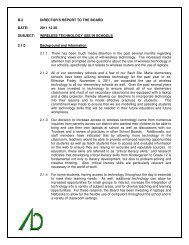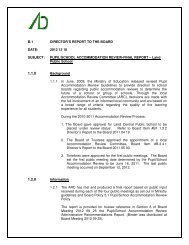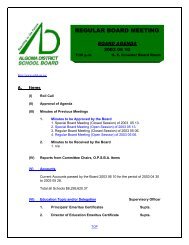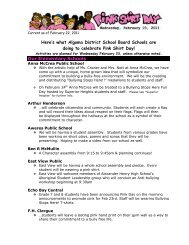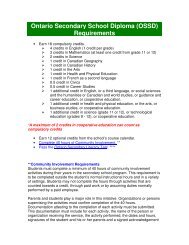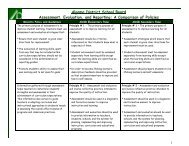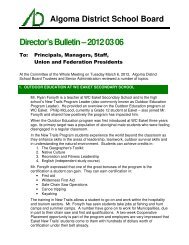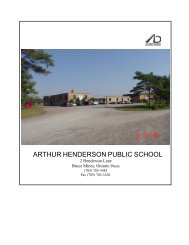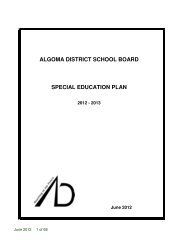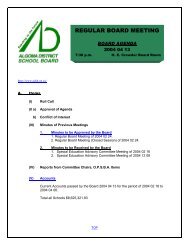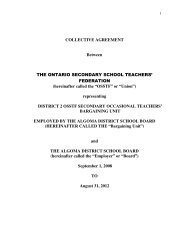Educating Our Educators (March 2011) - Algoma District School Board
Educating Our Educators (March 2011) - Algoma District School Board
Educating Our Educators (March 2011) - Algoma District School Board
- No tags were found...
Create successful ePaper yourself
Turn your PDF publications into a flip-book with our unique Google optimized e-Paper software.
Aboriginal Peoples in OntarioThe Aboriginal population in Ontario is composed of many different nations, however, the largest tribes include:Anishinaabe (Ojibwe), Odawa, Pottawatomi, Mushkegowuk (formerly known as Swampy Cree), Oji-CreeHaudenesaunee and Métis.In Northern Ontario, there are three major First Nations: Anishinaabe (Ojibwe), Oji-Cree and MushkegowukCree and the Métis Nation.AnishinaabeIn Ontario, the term Anishinaabe most often refers to the three nations that formed a Confederacyknown as the Three Fires Confederacy: Ojibwe (Faith Keepers), Odawa (Warriors and Traders),and Potawatomi (Fire Keepers). The Anishinaabe have a long and proud history:Language of these three nations belongs to the Algonkian family.They share similar cultural practices and spiritual beliefs.History of Anishinaabe began on the east coast of Turtle Island (North America) long before Europeancontact.Seven prophets came to the Anishinaabe people at that time and foretold of the European people andfuture hardships.For survival, they urged the people to migrate and their prophecy is known as the Seven FiresProphecy.Seven Fires refers to the seven places of migration along the way: St. Lawrence River (of a turtleshapedisland), Niagara Falls, the Detroit River, Manitoulin Island, Bawating (Sault Ste. Marie),Duluth, and finally Madeline Island (Wisconsin).In 1650, the Ojibwe fled from the Iroquois, but later in this century the Ojibwe went on the offensive anddrove the Iroquois from most of southern Ontario.By the mid 1700's, Three Fires Confederacy became the core of the Western Lakes Confederacy,and was joined by the Huron, Algonquins, Nipissing, Sauks, Foxes and others.They met on a regular basis at their own fire within that of the larger council, where each nation woulddebate its position internally. Once in agreement, one speaker would share it with the GrandCouncil.After 1812, the British did not need allies and stopped treating the members of the Western LakesConfederacy with respect or fairness. During the following decades, many treaties took land fromAboriginal peoples. In 1870, the Grand General Indian Council of Ontario and Quebec met (with almost all bands of S.Ontario and Lake Huron taking part) to review and revise the Indian Act of 1876. By the early 1900's, the Grand Council began to decline, as the Indian agents began to refuse or allowthe use of band funds for travel. In 1949, the Grand Indian Council was replaced by the Union of Ontario Indians (UOI), which todayrepresents 43 First Nations along Lake Huron and Lake Superior and in the southern parts of Ontario<strong>Educating</strong> <strong>Our</strong> <strong>Educators</strong> – <strong>Educating</strong> <strong>Our</strong> Aboriginal StudentsRevised <strong>March</strong> <strong>2011</strong>29



